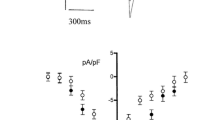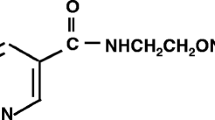Abstract
We examined the intracellular mechanisms for endothelin-1-induced positive and negative inotropic components that coexist in the mouse ventricular myocardium using isolated ventricular tissue and myocytes from 4-week-old mice. In the presence of SEA0400, a specific inhibitor of the Na+–Ca2+ exchanger, endothelin-1 produced positive inotropy. Endothelin-1, when applied to cardiomyocytes in the presence of SEA0400, did not change the peak amplitude of the Ca2+ transient but increased intracellular pH and Ca2+ sensitivity of contractile proteins. On the other hand, in the presence of dimethylamiloride (DMA), a specific inhibitor of the Na+–H+ exchanger, endothelin-1 produced negative inotropy. In cardiomyocytes, in the presence of DMA, endothelin-1 produced a decrease in peak amplitude of the Ca2+ transient. In the presence of both DMA and SEA0400, endothelin-1 produced neither positive nor negative inotropy. Positive inotropy was blocked by BQ-123 and negative inotropy by BQ-788. These results suggested that endothelin-1-induced positive inotropy is mediated by ETA receptors, activation of the Na+–H+ exchanger and an increase in intracellular pH and Ca2+ sensitivity and that the negative inotropy is mediated by ETB receptors, activation of the Na+–Ca2+ exchanger and decrease in Ca2+ transient amplitude.






Similar content being viewed by others
References
Baartscheer A, Schumacher CA, van Borren MM, Belterman CN, Coronel R, Fiolet JW (2003) Increased Na+/H+-exchange activity is the cause of increased [Na+]i and underlies disturbed calcium handling in the rabbit pressure and volume overload heart failure model. Cardiovasc Res 57:1015–1024
Barth E, Stammler G, Speiser B, Schaper J (1992) Ultrastructural quantitation of mitochondria and myofilaments in cardiac muscle from 10 different animal species including man. J Mol Cell Cardiol 24:669–681
Bassnett S, Reinisch L, Beebe D (1990) Intracellular pH measurement using single excitation-dual emission fluorescence ratios. Am J Physiol 258:C171–C178
Bers D (2002) Cardiac Na+/Ca2+ exchange function in rabbit, mouse and man: what’s the difference? J Mol Cell Cardiol 34:369–373
Bers D, Despa S (2006) Cardiac myocytes Ca2+ and Na+ regulation in normal and failing hearts. J Pharmacol Sci 100:315–322
Binah O, Arieli R, Beck R, Rosen MR, Palti Y (1987) Ventricular electrophysiological properties: is interspecies variability related to thyroid state? Am J Physiol 252:H1265–H1274
Blank S, Chen V, Hamilton N, Salemo T, Ianuzzo C (1989) Biochemical characteristics of mammalian myocardia. J Mol Cell Cardiol 21:367–373
Chess-Williams R, Broadley K (1987) Examination of cardiac alpha-adrenoceptors from pharmacological responses and radioligand binding. Comparison of rat and guinea pig tissues. J Pharmacol Methods 18:111–122
Chu L, Takahashi R, Norota I, Miyamoto T, Takeishi Y, Ishii K, Kubota I, Endoh M (2003) Signal transduction and Ca2+ signaling in contractile regulation induced by crosstalk between endothelin-1 and norepinephrine in dog ventricular myocardium. Circ Res 92:1024–1032
Chu L, Norota I, Yomogida S, Ishii K, Endoh M (2004) Differential inotropic effects of endothelin-1, angiotensin II, and phenylephrine induced by crosstalk with cAMP-mediated signaling process in dog ventricular myocardium. J Pharmacol Sci 96:199–207
Endoh M (2006) Signal transduction and Ca2+ signaling in intact myocardium. J Pharmacol Sci 100:525–537
Fujiki S, Takeda K, Moriwaki R, Shimizu Y, Kazama A, Namekata A, Kawanishi T, Tanaka H, Shigenobu K (2006) Intracellular mechanisms for the endothelin-induced negative and positive inotropy in adult mouse ventricle. J Pharmacol Sci 100:224P
Gray G, Webb D (1996) The endothelin system and its potential as a therapeutic target in cardiovascular disease. Pharmacol Ther 72:109–148
Hamilton N, Ianuzzo C (1991) Contractile and calcium regulating capacities of myocardia of different sized mammals scale with resting heart rate. Mol Cell Biochem 106:133–141
Hobai IA, O’Rourke B (2000) Enhanced Ca2+-activated Na+–Ca2+ exchange activity in canine pacing-induced heart failure. Circ Res 87:690–698
Hongo K, Kusakari Y, Kawai M, Konishi M, Kurihara S, Mochizuki S (2002) Use of tetanus to investigate myofibrillar responsiveness to Ca2+ in isolated mouse ventricular myocytes. Jpn J Physiol 52:121–127
Hurtado C, Ander BP, Maddaford TG, Lukas A, Hrysko LV, Pierce GN (2005) Adenovirally delivered shRNA strongly inhibits Na+–Ca2+ exchanger expression but does not prevent contraction of neonatal cardiomyocytes. J Mol Cell Cardiol 38:647–654
Ihara M, Ishikawa K, Fukuroda T, Saeki T, Funabashi K, Fukami T, Suda H, Yano M (1992) In vitro biological profile fo a highly potent novel endothelin (et) antagonist BQ-123 selective for the ETA receptor. J Cardiovasc Pharmacol 20(Suppl 12):S11–S14
Ishikawa K, Ihara M, Noguchi K, Mase T, Mino N, Saeki T, Fukuroda T, fukami T, Ozaki S, Nagase T, Nihikibe M, Yano M (1994) Biochemical and pharmacological profile of a potent and selective endothelin B-receptor antagonist, BQ-788. Proc Natl Acad Sci USA 91:4892–4896
Izumi M, Miyamoto S, Hori M, Ozaki H, Karaki H (2000) Negative inotropic effect of endothelin-1 in the mouse right ventricle. Eur J Pharmacol 396:109–117
Kelso EJ, McDermott BJ, Silke B, Spiers JP (2000) Endothelin A receptor subtype mediates endothelin-induced contractility in left ventricular cardiomyocytes isolated from rabbit myocardium. J Pharmacol Exp Ther 294:1047–1052
Kramer B, Smith T, Kelly R (1991) Endothelin and increased contractility in adult rat ventricular myocytes. Role of intracellular alkalosis induced by activation of the protein kinase C-dependent Na+–H+ exchanger. Circ Res 68:269–279
Lauer M, Gunn M, Clusin W (1992) Endothelin activates voltage-dependent Ca2+ current by a G protein-dependent mechanism in rabbit cardiac myocytes. J Physiol 448:729–747
MacCarthy P, Grocott-Mason R, Prendergast B, Shah A (2000) Contrasting inotropic effects of endogenous endothelin in the normal and failing human heart: studies with an intracoronary ET(A) receptor antagonist. Circulation 101:142–147
Malo ME, Fliegel L (2006) Physiological role and regulation of the Na+/H+ exchanger. Can J Physiol Pharmacol 84:1081–1095
Matsuda T, Arakawa N, Takuma K, Kishida Y, Kawasaki Y, Sakaue M, Takahashi K, Takahashi T, Suzuki T, Ota T, Hamano-Takahashi A, Onishi M, Tanaka Y, Kameo K, Baba A (2001) SEA0400, a novel and selective inhibitor of the Na+–Ca2+ exchanger, attenuates reperfusion injury in the in vitro and in vivo cerebral ischemic models. J Pharmacol Exp Ther 298:249–256
Matsui H, Barry WH, Livsey C, Spitzer KW (1995) Angiotensin II stimulates sodium-hydrogen exchange in adult rabbit ventricular myocytes. Cardiovasc Res 29:215–221
Nagasaka T, Izumi M, Hori M, Ozaki H, Karaki H (2003) Positive inotropic effect of endothelin-1 in the neonatal mouse right ventricle. Eur J Pharmacol 472:197–204
Namekata I, Kawanishi T, Iida-Tanaka N, Tanaka H, Shigenobu K (2006) Quantitative fluorescence measurement of cardiac Na+/Ca2+ exchanger inhibition by kinetic analysis in stably transfected HEK293 cells. J Pharmacol Sci 101:356–360
Nishimaru K, Tanaka Y, Tanaka H, Shigenobu K (2000) Positive and negative inotropic effects of muscarinic receptor stimulation in mouse left atria. Life Sci 66:607–615
Nishimaru K, Kobayashi M, Matsuda T, Tanaka Y, Tanaka H, Shigenobu K (2001) Alpha-Adrenoceptor stimulation-mediated negative inotropism and enhanced Na+/Ca2+ exchange in mouse ventricle. Am J Physiol Heart Circ Physiol 280:H132–H141
Nishimaru K, Tanaka Y, Tanaka H, Shigenobu K (2003) Pharmacological evidence for involvement of phospholipase D, protein kinase C, and sodium–calcium exchanger in alpha-adrenoceptor-mediated negative inotropy in adult mouse ventricle. J Pharmacol Sci 92:196–202
Nishimaru K, Miura Y, Endoh M (2007) Mechanisms of endothelin-1-induced decrease in contractility in adult mouse ventricular myocytes. Br J Pharmacol 152:456–463
Orchard CH, Kentish JC (1990) Effects of changes of pH on the contractile function of cardiac muscle. Am J Physiol 258:C967–C981
Penna C, Rastaldo R, Mancardi D, Cappello S, Pagliaro P, Westerhof N, Losano G (2006) Effect of endothelins on the cardiovascular system. J Cardiovas Med 7:645–652
Piuhola J, Makinen M, Szokodi I, Ruskoaho H (2003) Dual role of endothelin-1 via ETA and ETB receptors in regulation of cardiac contractile function in mice. Am J Physiol 285:H112–H118
Reuter H, Henderson SA, Han T, Mottino GA, Frank JS, Ross RS, Goldhaber JI, Philipson KD (2003) Cardiac excitation–contraction coupling in the absence of Na+–Ca2+ exchange. Cell Calcium 34:19–26
Sakurai K, Norota I, Tanaka H, Kubota I, Tomoike H, Endoh M (2002) Negative inotropic effects of angiotensin II, endothelin-1 and phenylephrine in indo-1 loaded adult mouse ventricular myocytes. Life Sci 70:1173–1184
Sekine T, Kusano H, Nishimaru K, Tanaka Y, Tanaka H, Shigenobu K (1999) Developmental conversion of inotropism by endothelin I and angiotensin II from positive to negative in mice. Eur J Pharmacol 374:411–415
Sipido KR, Volders PG, Vos MA, Verdonck F (2002) Altered Na/Ca exchange activity in cardiac hypertrophy and heart failure: a new target for therapy? Cardiovasc Res 53:782–805
Takanashi M, Endoh M (1991) Characterization of positive inotropic effect of endothelin on mammalian ventricular myocardium. Am J Physiol 261:H611–H619
Takahashi S, Kato Y, Adachi M, Agata N, Tanaka H, Shigenobu K (1995) Effects of cyclopiazonic acid on rat myocardium: inhibition of calcium uptake into sarcoplasmic reticulum. J Pharmacol Exp Ther 272:1095–1100
Tanaka H, Manita S, Shigenobu K (1994) Increased sensitivity of neonatal mouse myocardia to autonomic transmitters. J Auton Pharmacol 14:123–128
Tanaka H, Manita S, Matsuda T, Adachi M, Shigenobu K (1995a) Sustained negative inotropism mediated by alpha-adrenoceptors in adult mouse myocardia: developmental conversion from positive response in the neonate. Br J Pharmacol 114:673–677
Tanaka H, Matsuda T, Adachi M, Shigenobu K (1995b) Effect of sympathectomy on inotropic responsiveness to α-adrenoceptor stimulation in developing mouse myocardia. Can J Physiol Pharmacol 73:1285–1288
Tanaka H, Kawanishi T, Kato Y, Nakamura R, Shigenobu K (1996) Restricted propagation of cytoplasmic Ca2+ oscillation into the nucleus in guinea pig cardiac myocytes as revealed by rapid scanning confocal microscopy and indo-1. Jpn J Pharmacol 70:235–242
Tanaka H, Sekine T, Nishimaru K, Shigenobu K (1998) Role of sarcoplasmic reticulum in myocardial contraction of neonatal and adult mice. Comp Biochem Physiol A 120:431–438
Tanaka H, Nishimaru K, Kobayashi M, Matsuda T, Tanaka Y, Shigenobu K (2001) Acetylcholine-induced positive inotropy mediated by prostaglandin released from endocardial endothelium in mouse left atrium. Nauny-Schmied Arch Pharmacol 363:577–582
Tanaka H, Nishimaru K, Aikawa T, Hirayama W, Tanaka Y, Shigenobu K (2002) Effect of SEA0400, a novel inhibitor of sodium–calcium exchanger, on myocardial ionic currents. Br J Pharmacol 135:1096–1100
Tanaka H, Nishimaru K, Makuta R, Hirayama W, Kawamura T, Matsuda T, Tanaka Y, Kawanishi T, Shigenobu K (2003) Possible involvement of prostaglandins F2α and D2 in acetylcholine-induced positive inotropy in isolated mouse left atria. Pharmacology 67:157–162
Tanaka H, Komikado C, Shimada H, Takeda K, Namekata I, Kawanishi T, Shigenobu K (2004) The R(−)-enantiomer of efonidipine blocks T-type but not L-type calcium current in guinea pig ventricular myocardium. J Pharmacol Sci 96:499–501
Tanaka H, Namekata I, Takeda K, Kazama A, Shimizu Y, Moriwaki R, Hirayama W, Sato A, Kawanishi T, Shigenobu K (2005) Unique excitation–contraction characteristics of mouse myocardium as revealed by SEA0400, a specific inhibitor of Na+–Ca2+ exchanger. Nauny-Schmied Arch Pharmacol 371:526–534
Yanagisawa M, Kurihara H, Kimura S, Tomobe Y, Kobayashi M, Mitsui Y, Yazaki Y, Goto K, Masaki T (1988) A novel potent vasoconstrictor peptide produced by vascular endothelial cells. Nature 332:411–415
Acknowledgment
This study was partly performed as a part of the project Research on the Molecular Mechanisms of Appearance of Age-related Diseases by Failure of Cell Function Control System, and their Prevention and Treatment by the Research Center for Aging and Age-related Diseases established in the Toho University Faculty of Pharmaceutical Sciences.
Author information
Authors and Affiliations
Corresponding author
Rights and permissions
About this article
Cite this article
Namekata, I., Fujiki, S., Kawakami, Y. et al. Intracellular mechanisms and receptor types for endothelin-1-induced positive and negative inotropy in mouse ventricular myocardium. Naunyn-Schmied Arch Pharmacol 376, 385–395 (2008). https://doi.org/10.1007/s00210-007-0228-9
Received:
Accepted:
Published:
Issue Date:
DOI: https://doi.org/10.1007/s00210-007-0228-9




